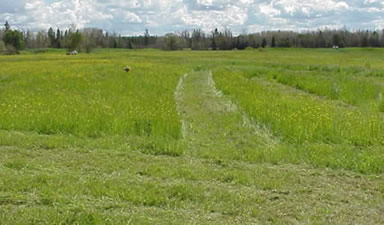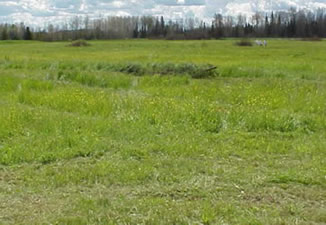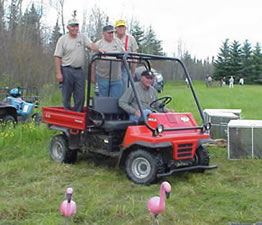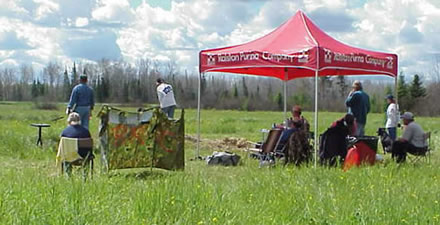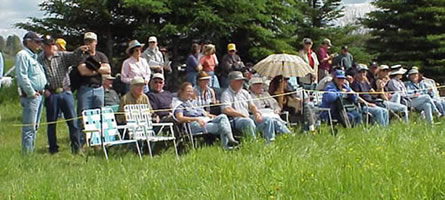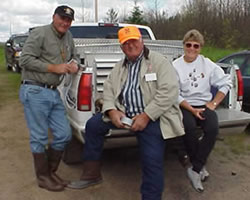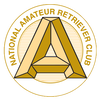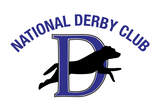Wednesday, June 20, 2001 |
Test 5 - Land Double-Double
After last night's storms, Wednesday began clear, cool, with little wind and temperatures in the mid 50's. Although clear early, more rain was forecast for the afternoon.
Site five was on the Minnesota Iron Range Club grounds, a short way down the road from the clubhouse and was billed as a land "Double-Double" with a walk-up and an honor.
The line was on top a small mound that faced a flat randomly mowed, grassy field containing several large bushes and a group of mounds located on the far left. There were four sets of guns positioned in the field in nearly a180 degree spread. On the far left, a live flyer station shot a flying rooster to the right. It landed about 135 yards away. A good distance away and deep to their right, a second set was atop the mounds. They threw a dead duck flat to the right where it fell on the flat below, 160 yards from line. To their right, and closer to the line, a (middle right) station stood next to a large bush and threw a dead rooster flat to the right, only about 113 yards out. The far right station was a relatively short distance and a bit closer to line on their right. They simulated a flyer by having three guns fire two shots and throw a dead duck back to the right. It fell about 103 yards away. There was an honor mat to the right of the running mat and a fallen fir tree (15+ feet ?) had been laid parallel to and about 15 yards in front off the line as an obstacle to the short, right middle mark.
Judges explained that the test consisted of a Double-Double as there would be two separate sets of marks thrown to comprise the test. Handlers would walk up to the line and be given a brief period to "sit" their dogs before judges signaled for the marks. The first pair would be the right, middle first; then the far left flyer. As the dog retrieved the flyer, the short guns retired behind the bush and the left middle and far right gunners appeared from behind the mound and bush respectively, where they were were concealed as the first birds went down. (Once back on line with the flyer, judges again signaled for the other two marks. The left middle threw first, followed by the far right, simulated flyer. The handler was given a number prior to sending on each double. After the dog recovered the far right bird, handlers were left with their choice of the remaining two.
Shortly before 8 a.m., both test dogs recovered the birds cleanly. It took about 6+ minutes to complete. About 8:15, the first running dog, #8 appeared on line. The fast paced test gave dogs only brief views of each mark. The flyer distracted dogs from a good look at the short retired bird. That fact combined with another two falls after, dimmed dog's memories of the two middle marks. Early dogs had downwind conditions and less scent. Later a variable wind angled back across the test.
Contestants recovered the outside bird first, some hunting the various flyer falls. They then faced the decision of which bird to take next. A number tried for the short right, middle retired one next. A number of dogs blew through it and recoverd the left middle one instead while others hunted wide and deep or lined past it as if on a blind. A good number had to be handled to it. Some took the left middle one third, hoping to avoid the previous predicament, but that also proved unreliable and handles resulted.
After the first gun change, Judge Steve Parker had the dubious honor of being serenaded with "Happy Birthday" by the crowd in celebration of his special day.
By early afternoon, building scent and breezy conditions aided dogs and work improved. However of the first 60 dogs to run, 20 had handled. The test was expected to be completed prior to the workers party scheduled for HQ at 6:30 p.m. Call backs arrived during the party and there were 55 numbers invited to the sixth. Unfortunately, 20 had been lost. They were: 5, 10, 25, 32, 34, 35, 38, 41, 50, 51, 58, 59, 64, 72(77 was originally reported as dropped instead of 72- sorry) 79, 82, 83, 88, 100, and 102. The seventh would be a water triple at the MIR grounds. Test dogs, 7:30 a.m., first running dog, #11.
Site five was on the Minnesota Iron Range Club grounds, a short way down the road from the clubhouse and was billed as a land "Double-Double" with a walk-up and an honor.
The line was on top a small mound that faced a flat randomly mowed, grassy field containing several large bushes and a group of mounds located on the far left. There were four sets of guns positioned in the field in nearly a180 degree spread. On the far left, a live flyer station shot a flying rooster to the right. It landed about 135 yards away. A good distance away and deep to their right, a second set was atop the mounds. They threw a dead duck flat to the right where it fell on the flat below, 160 yards from line. To their right, and closer to the line, a (middle right) station stood next to a large bush and threw a dead rooster flat to the right, only about 113 yards out. The far right station was a relatively short distance and a bit closer to line on their right. They simulated a flyer by having three guns fire two shots and throw a dead duck back to the right. It fell about 103 yards away. There was an honor mat to the right of the running mat and a fallen fir tree (15+ feet ?) had been laid parallel to and about 15 yards in front off the line as an obstacle to the short, right middle mark.
Judges explained that the test consisted of a Double-Double as there would be two separate sets of marks thrown to comprise the test. Handlers would walk up to the line and be given a brief period to "sit" their dogs before judges signaled for the marks. The first pair would be the right, middle first; then the far left flyer. As the dog retrieved the flyer, the short guns retired behind the bush and the left middle and far right gunners appeared from behind the mound and bush respectively, where they were were concealed as the first birds went down. (Once back on line with the flyer, judges again signaled for the other two marks. The left middle threw first, followed by the far right, simulated flyer. The handler was given a number prior to sending on each double. After the dog recovered the far right bird, handlers were left with their choice of the remaining two.
Shortly before 8 a.m., both test dogs recovered the birds cleanly. It took about 6+ minutes to complete. About 8:15, the first running dog, #8 appeared on line. The fast paced test gave dogs only brief views of each mark. The flyer distracted dogs from a good look at the short retired bird. That fact combined with another two falls after, dimmed dog's memories of the two middle marks. Early dogs had downwind conditions and less scent. Later a variable wind angled back across the test.
Contestants recovered the outside bird first, some hunting the various flyer falls. They then faced the decision of which bird to take next. A number tried for the short right, middle retired one next. A number of dogs blew through it and recoverd the left middle one instead while others hunted wide and deep or lined past it as if on a blind. A good number had to be handled to it. Some took the left middle one third, hoping to avoid the previous predicament, but that also proved unreliable and handles resulted.
After the first gun change, Judge Steve Parker had the dubious honor of being serenaded with "Happy Birthday" by the crowd in celebration of his special day.
By early afternoon, building scent and breezy conditions aided dogs and work improved. However of the first 60 dogs to run, 20 had handled. The test was expected to be completed prior to the workers party scheduled for HQ at 6:30 p.m. Call backs arrived during the party and there were 55 numbers invited to the sixth. Unfortunately, 20 had been lost. They were: 5, 10, 25, 32, 34, 35, 38, 41, 50, 51, 58, 59, 64, 72(77 was originally reported as dropped instead of 72- sorry) 79, 82, 83, 88, 100, and 102. The seventh would be a water triple at the MIR grounds. Test dogs, 7:30 a.m., first running dog, #11.

